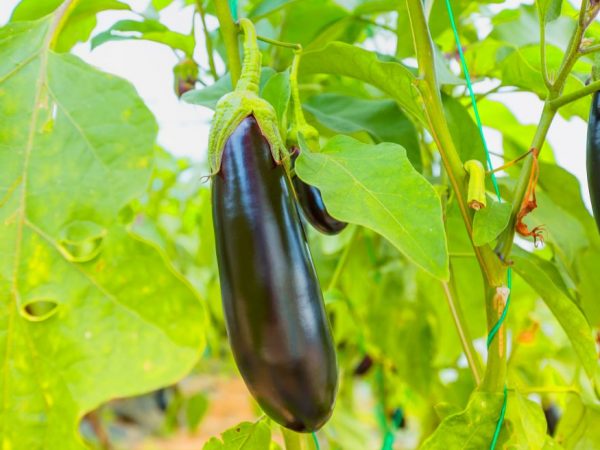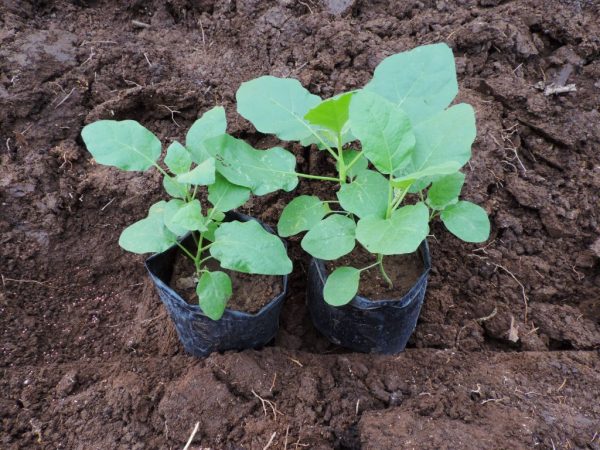Eggplant Roma F1
Eggplant Roma F1 is one of the most productive varieties. The vegetable is popular with gardeners because of its unpretentiousness to growing conditions. The variety is early maturing.

Eggplant Roma F1
Variety characteristic
Eggplant Roma F1 is grown in any region. About 1.5 kg of eggplant can be harvested from one bush. With a square-nesting method of planting, plants can give a total of up to 6 kg of fruit. It is possible to grow a vegetable both in the open field and in greenhouses. Bushes grow up to 2 m in height.
Features of the Roma F1 eggplant variety:
- Resistant to diseases affecting nightshades.
- Moisture-loving. With a lack of moisture, the water bends and falls off.
- Mid-season. From the moment of emergence to harvesting, no more than 140 days pass.
- Heat-loving. The optimum air temperature is close to 24 ° C. Lower rates lead to dropping of the ovary.
Description of fruits
- The skin is thin and soft to the touch. In ripe vegetables, it is shiny. Fruit color is dark purple.
- The size of the fruit is from 20 to 25 cm, and the maximum weight of one vegetable reaches 350 g.
- The pulp is dense on the slices. It is painted ivory.
- There is no bitterness in the taste. The fruits are used for preparing pickles for the winter, stewing and frying, as well as pickling.
- The grains in the fruits are small and few. This is due to the fact that the plant belongs to hybrids and the seeds collected from the fruits do not multiply.
Eggplant fruits of the Roma variety have a high keeping quality and excellent transportability. Storage does not require special conditions.
Growing seedlings
Growing in regions with a temperate climate is carried out in seedlings. In southern latitudes, the vegetable is sown directly into the holes.
Sowing seeds for seedlings begins, depending on the region, in late February - early March. The seed is germinated throughout the day in a weak solution of potassium permanganate or using a means to increase germination.
The planting depth is 1 cm. It is preferable to sow seeds in separate containers, the volume of which is more than 150 ml. Put 1 swollen seed in each glass and sprinkle it with earth with a layer of 1 cm.
The land for sowing is used with the mark "For seedlings" or it is prepared in the fall by combining:
- 20 pieces of sod land;
- 10 parts of humus;
- 3 parts of peat.
Before sowing a vegetable, the soil is abundantly watered with a solution of potassium permanganate and heated in a room under a film for at least 10 days. The biological product Fitosporin is also used as a disinfectant.
The first shoots appear on the 7th day. Until this time, the container with the seeds is left covered with a film. Growing seedlings of eggplant varieties Roma F1, they provide plants with:
- daylight hours with a duration of 14 hours;
- absence of drafts and temperature drops in the room;
- regular watering.
There is no need to feed seedlings in pots. Water for irrigation is used only warm and settled.
Landing in open ground

Seedlings can be planted in mid-May
It is more optimal to transfer seedlings to open ground or to greenhouses in the second decade of May.Seedlings are taken out together with a lump of earth and placed in a previously prepared hole. After that, sprinkle with fathoms and lightly tamp the hole with your hands. After the operation, the beds with plants are abundantly watered.
The bushes are located in an area with good lighting and protected from gusty winds. You need to prepare holes at a distance of 60 cm from each other. The best planting method is square-nested.
Top dressing
Eggplant seedlings need multiple feeding, regardless of the structure and nutritional value of the substrate in which they grow. Only plants planted in a permanent place are fertilized. They do this 3 times per season:
- 2 weeks after transplant;
- at the beginning of the appearance of buds;
- during the ripening period of the crop.
The best fertilizers for the first feeding are cow dung or bird droppings diluted in water. The second dressing should contain:
- potassium;
- manganese;
- phosphorus;
- iron.
The third top dressing consists of phosphorus and potassium. It is always done 40 days before harvesting. That is why, at this stage, chemical compositions are not used that contribute to the accumulation of nitrates in fruits, but are limited to simple compositions.
Watering
Watering should be regular and abundant. Be sure to water the soil after applying mineral fertilizers. The best liquid for irrigation is water that has been kept for several days. During this time, it will heat up and get rid of chlorine.
Watering frequency depends on weather conditions. Reduce watering on cold days. To retain moisture on hot days, the soil is mulched. Indicators of lack of moisture:
- drooping leaves;
- falling buds;
- ovary loss:
- yellowing of fruits.
Excess moisture also has a negative effect on fruits and plants. This is evidenced by stem decay and fruit spoilage.
Diseases and pests
According to the description of the eggplant variety Roma F1, it is resistant to pathogens that cause the main diseases of the nightshade: phytosporosis and gray rot. Particular attention is paid to the fight against the Colorado potato beetle, whose larvae can eat all the leaves on the bush in a day, which must be fought from the moment the plants are planted in the ground.
To scare off the pest, folk remedies or short-acting insecticides are used, which mainly kill the larvae. The last processing of plants is carried out at least 1 month before harvesting.
Conclusion
Roma F1 eggplants are used in cooking and canning. Growing it is no more difficult than cultivating any other varieties of such a crop. The vegetable does not require special care or keeping conditions.
Put into practice the secrets and rules of caring for seedlings and seedlings in a permanent place to get a high quality crop.


